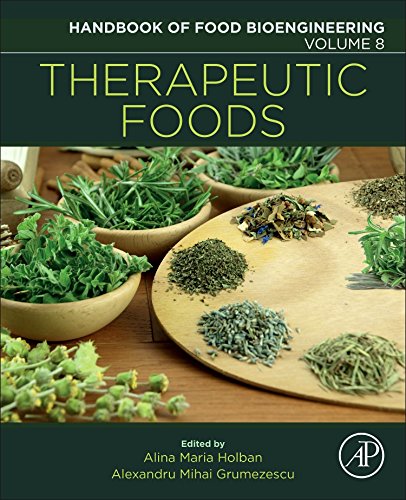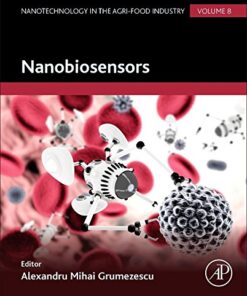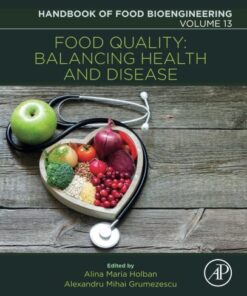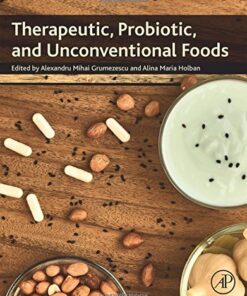(PDF) Therapeutic Foods By Alina Maria Holban
$22.00
Download instantly Therapeutic Foods By Alina Maria Holban, Alexandru Mihai Grumezescu. It is ebook in PDF format.
ISBN-10: 0128112662 ISBN-13: 9780128112663
Preview
This is the PDF eBook version for Therapeutic Foods By Alina Maria Holban, Alexandru Mihai Grumezescu
Table of Contents
Foreword
Series Preface
Preface for Volume 8: Therapeutic Foods
Section I: State of the Art and Applications
Chapter 1: Nutraceuticals: Myths Versus Realities
Abstract
1. Nutraceuticals
2. Natural, Nutraceuticals, and Pharmaceuticals
3. Nutraceuticals: Myths Versus Realities
4. Health Claims of Nutraceuticals
5. Labeling Requirements
6. Safety and Quality Issues
7. Global Regulations and Compliance
8. Role of Nutraceuticals in Human Health
9. Conclusions
Chapter 2: The Impact of Functional Food and Nutraceuticals in Health
Abstract
1. Introduction
2. Disease Patterns Arising From a 21st-Century Lifestyle
3. Food as Medicine
4. Challenges With Natural Nutrient Supplement
5. Allopathic Drugs and Challenges
6. Nutrients as Adjunct for Chemical Drugs
7. Nutrient Adjuncts for Cancer Therapy
8. Advancement in Food Processing for Nutrients
9. Conclusions
Acknowledgments
Section II: Nutrition
Chapter 3: Lipids as Nutraceuticals: A Shift in Paradigm
Abstract
1. Introduction
2. Classification of Lipids
3. Biological Functions of Lipids
4. Lipid Transport
5. Lipids in Pathogenesis of Diseases
6. Lipids as Nutraceuticals
Chapter 4: Plant Nutrition and Agronomic Management to Obtain Crops With Better Nutritional and Nutraceutical Quality
Abstract
1. Introduction
2. The Nutritional and Nutraceutical Quality of Crops
3. Nutraceutical Value of Plant Crops and Human Health
4. Regulation of the Synthesis and Accumulation of Compounds That Enhance the Nutraceutical Quality of Plant Foods
5. Agricultural Practices for Improving the Nutraceutical Quality of Crops
6. Results of Applying Agricultural Practices on Nutraceutical Quality
7. Conclusions
Chapter 5: Mushrooms as Sources of Therapeutic Foods
Abstract
1. Introduction to Mushrooms as Therapeutic Foods
2. Cultivation Technologies for Edible and Medicinal Mushrooms
3. Mushrooms Uses in Traditional Medicine Versus Scientific Confirmation for the Uses
4. Agaricus spp.
5. Antrodia spp.
6. Boletus spp.
7. Cordyceps spp.
8. Ganoderma spp.
9. Hericium spp.
10. Laetiporus spp.
11. Lentinula spp.
12. Phellinus spp.
13. Trametes spp.
14. Miscellaneous Mushrooms
15. Conclusions
Acknowledgments
Chapter 6: Oregano: A Feed Additive With Functional Properties
Abstract
1. Introduction
2. Antimicrobial Growth Promoters
3. Oregano Essential Oil
4. Modes of Action of Oregano
5. Use of Oregano in Animal Nutrition
6. Conclusions
Chapter 7: Potential of Chokeberry (Aronia Melanocarpa L.) as a Therapeutic Food
Abstract
1. Introduction
2. Chokeberry (Aronia melanocarpa)
3. Bioavailability and Metabolism of Polyphenols Present in Chokeberry
4. Chokeberry Products-Extracts
5. New Technologies in Chokeberry Products
6. Conclusions
Acknowledgments
Chapter 8: Beta Glucan as Therapeutic Food
Abstract
1. History
2. New Discoveries
3. Nutrition and Immunity
4. Why the Immune Responses are Dependent on Nutrition
5. Beta Glucans
6. Transport Through the Gastrointestinal Tract
7. Beta Glucan and Immunity
8. Beta Glucan as Food Additive
9. Conclusions
Acknowledgment
Chapter 9: Nutritionally Enhanced Foods Incorporating Chía Seed
Abstract
1. Introduction
2. Therapeutic Foods
3. History and Ethnobotanical Aspects of Chia
4. Some Reports on Use of Chia Seed as Food Ingredient
5. Conclusions
Section III: Medical Impact
Chapter 10: Perspective Therapeutic Effects of Immunomodulating Acidic Herbal Heteropolysaccharides and Their Complexes in Functional and Dietary Nutrition
Abstract
Abbreviations
1. Introduction
2. Chemical Diversity of Herbal Acidic Heteropolysaccharides and Relation to Immunogenicity
3. Perspective Therapeutic Effects of Acidic Heteropolysaccharides
4. Preparation of Immunomodulating Acidic Heteropolysaccharides and Their Complexes
5. Concluding Remarks
Acknowledgments
Chapter 11: Soybeans, Flaxseeds, and Fish Oil in the Treatment of Renal Disease
Abstract
1. Introduction
2. Sources, Dietary, and Supplement Intake
3. Clinical Association of Soybeans, Flaxseed, and Fish Oil Treatments in CKD
4. Conclusions
Acknowledgments
Chapter 12: Maca, A Nutraceutical From the Andean Highlands
Abstract
1. Introduction
2. A Crop Native From the Peruvian Highlands
3. The Tradition Behind Maca
4. The Science Behind Maca
5. The Future of Maca
6. Concluding Remarks
Acknowledgments
Chapter 13: Phytochemical and Pharmacological Properties of Secondary Metabolites in Berries
Abstract
1. Introduction
2. Taxonomic Problems
3. Berry Fruits, Bioactives, and Bioavailability
4. Metabolic Syndrome
5. Clinical Efficacy and Mechanism of Action Berries
6. Cancer and Oxidative Species
7. Types of Cancer With Potential to be Treated by Medicinal Plants
8. Epidemiological Studies of Cancer
9. Conclusions
Section IV: Cancer Therapy
Chapter 14: Functional Foods and Chemoprevention in Cancer
Abstract
1. Functional Foods and Bioactive Compounds
2. Bioactive Compounds With Anticancer Activity
3. Conclusions
Chapter 15: Epigenetic Nutraceuticals in Cancer Treatment
Abstract
1. Introduction
2. Diet and Transgenerational Epigenetic Changes
3. Epigenetic Nutraceuticals in Cancer Treatment
4. Essential Micronutrients–Folate, Selenium, Vitamin D
5. Flavonoids
6. Polyphenol Catechins
7. Conclusions, Future Perspectives, and Challenges
Index




